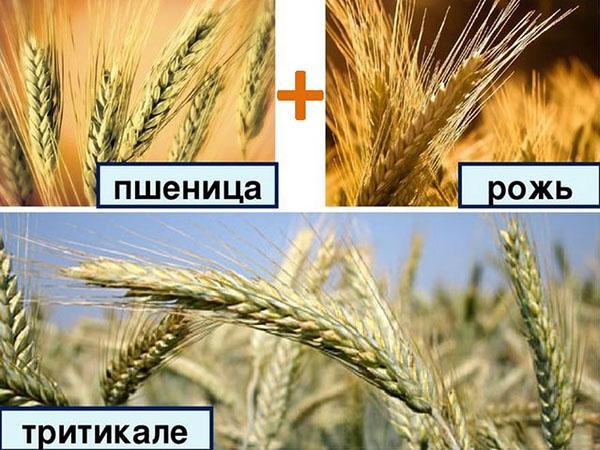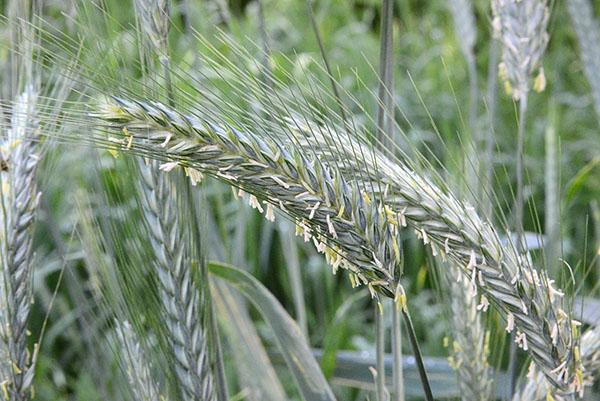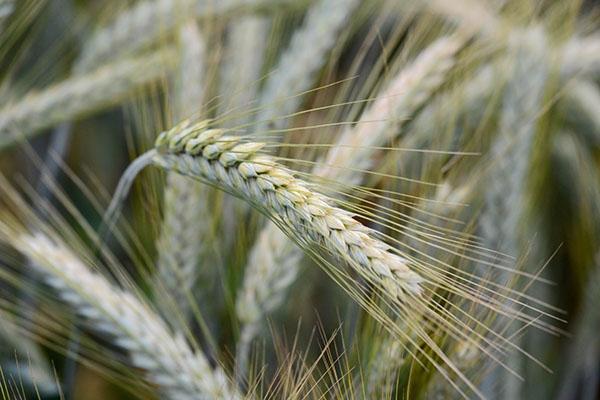Triticale is a hybrid of rye and wheat in the fields of our country
 Triticale (a hybrid of rye and wheat) is a plant with unique properties due to the fact that it combines the characteristics of two grain crops at once. A botanical species specially bred by scientists got its name from the fusion of parts of two Latin words - triticum (wheat) and secale (rye). This culture is used in cooking to make bread and other baked goods. It is also used in agriculture for fattening livestock.
Triticale (a hybrid of rye and wheat) is a plant with unique properties due to the fact that it combines the characteristics of two grain crops at once. A botanical species specially bred by scientists got its name from the fusion of parts of two Latin words - triticum (wheat) and secale (rye). This culture is used in cooking to make bread and other baked goods. It is also used in agriculture for fattening livestock.
Triticale (hybrid of rye and wheat): general information

Among the key advantages of this hybrid crop are the following:
- High yield of triticale (more than 5000 kg of grain from 1 ha of land).
- A unique ear, which received the property of multiflowering from wheat, and multiflorous from rye.
- Large grains.
- Disease and pest resistance.
- Self-pollination ability.
- The ability to grow on any soil, in almost any weather conditions.
- Tall stems, which are used to feed cows and pigs.
- Protein-rich grains that provide faster and more balanced feeding of poultry and animals.
There are triticale (a hybrid of rye and wheat) and a number of negative characteristics that do not allow the use of the crop as widely as, for example, wheat.
Among the physical disabilities are:
- difficulties with milk production of ears, as the grains are poorly separated from the chaff;
- late ripeness;
- plants often suffer from snow mold and root rot.
 The more serious problem is that this is a clear result of genetic engineering. There is no data on how products from such a plant can affect animals or humans. Because of this, triticale is not widespread enough in the CIS countries.
The more serious problem is that this is a clear result of genetic engineering. There is no data on how products from such a plant can affect animals or humans. Because of this, triticale is not widespread enough in the CIS countries.
Rules for growing triticale

Different varieties of triticale (a hybrid of rye and wheat) are divided into:
- spring crops grown exclusively on animal feed;
- winter crops, which can be both grain fodder and grain.
In general terms, the process of cultivating this plant is no different from cultivating wheat or rye.
However, it is worth knowing about some small features:
- Triticale will grow best on black soil, although the yield will be good enough on sandy or peaty soils.
- To achieve higher yields, it is worth planting triticale after corn, peas or early potato varieties.
- It is best to apply manure and phosphate-potassium fertilizers to the soil before plowing.
- Sowing is most often carried out in September to a depth of 5-10 cm. In this case, the first shoots should appear within 7 days.
- The seeding rate of a plant ranges from 150 to 300 kg per 1 ha, depending on the climatic characteristics of the sowing region.
- The critical temperature is 20 ° C frost, which characterizes triticale (wheat hybrid) as an extremely hardy plant, which, however, can also freeze out.
- The hybrid withstands winds and rains well, thanks to a successful root system - fibrous and moderately deep.
 In addition, it is important to understand that the plant must be protected from parasites, diseases and weeds, as well as fed on time. Both organic matter and minerals can be used as top dressing. It is best to use fertilizers that contain potassium, nitrogen and phosphorus - this will help the plant to form better stems and maintain its frost resistance.
In addition, it is important to understand that the plant must be protected from parasites, diseases and weeds, as well as fed on time. Both organic matter and minerals can be used as top dressing. It is best to use fertilizers that contain potassium, nitrogen and phosphorus - this will help the plant to form better stems and maintain its frost resistance.
The sowing period for triticale roughly coincides with the sowing period for winter wheat.
Harvesting can be carried out either separately (during the period of the wax maturity of the grains), and direct combining (when fully ripe). In case of stagnation of plants, the stems will break off, the grains will crumble, and, accordingly, the amount of the crop will decrease.
Applications of triticale
 Triticale is considered a grain culture. It can be widely used in the production of compound feed, starch, malt and flour.
Triticale is considered a grain culture. It can be widely used in the production of compound feed, starch, malt and flour.
Now the grains of the plant are most often used for feeding:
- cows;
- pigs;
- sheep;
- goats and other domestic animals.
By adding triticale grain to the feed mixture of pigs, you can get 20% more of the final product. The green mass of this plant, used in the diet of cattle, allows you to get 15-20% more milk yield.
It is quite common to find baked goods made from triticale in stores, as they are of better quality than those made from wheat flour. Cupcakes, cookies and gingerbread are very tasty and do not stale for a long time. Due to the fact that the bread from this hybrid grain comes out less and more fuzzy than from rye or wheat, manufacturers prefer to mix wheat flour and triticale flour in proportions 80/20 or 70/30, respectively.
This allows you to bake the highest quality product. Also, triticale is used in the production of ethyl alcohol and liquid biofuel, which further opens new horizons for culture.
Triticale is a unique plant that has actually managed to get the best characteristics from rye and wheat. Thanks to this, triticale can really get huge distribution. Significant yields at low cost will surely attract an increasing number of farmers who need to quickly and efficiently feed their livestock or thresh quality flour.